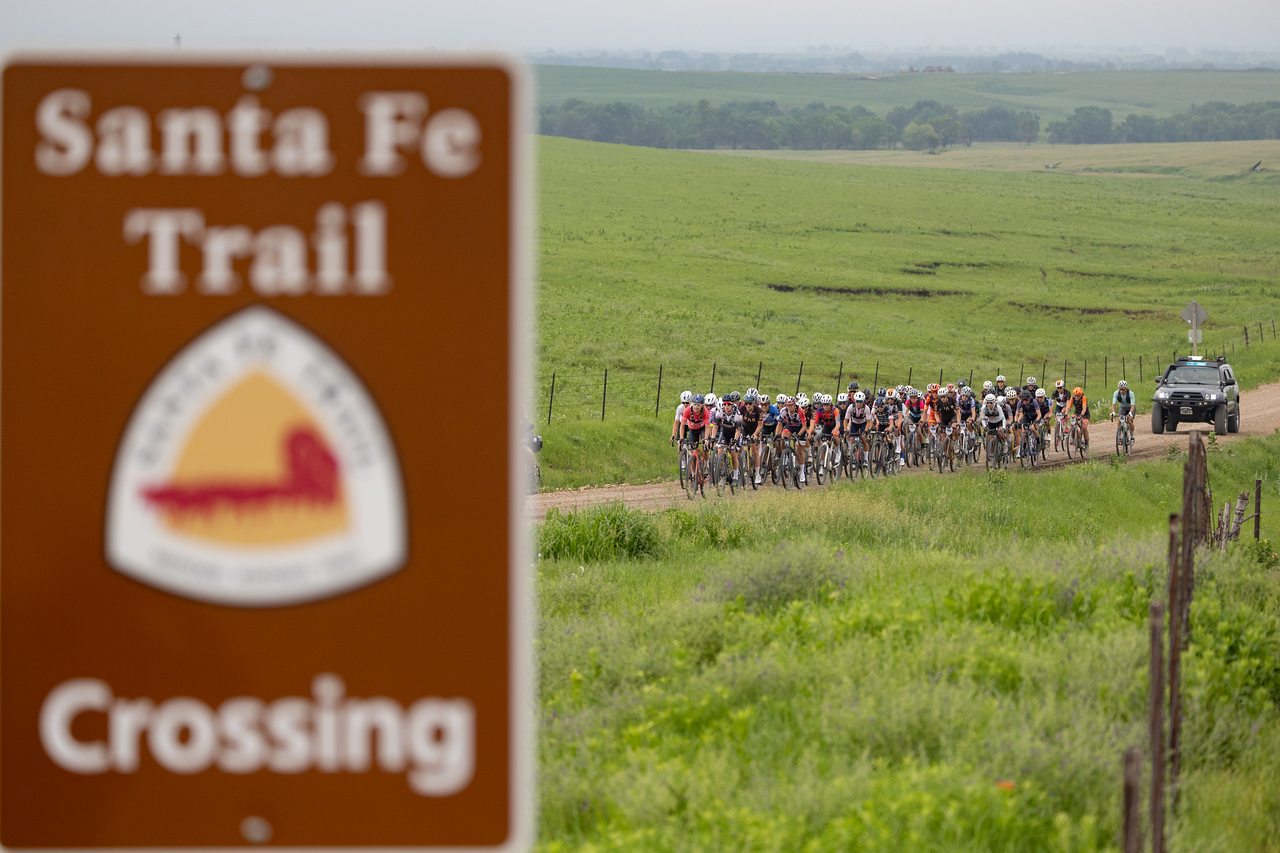Learning to ride a bike is one the key landmarks in childhood. Regardless of whether your child is a natural on two wheels, wobbling on a balance bike, or just scooting to school—the best kids’ bike helmets will keep your child safe as they learn to ride.
As a parent and lifelong cyclist, few things are more rewarding than watching my son discover the joy of riding bikes. Over the years, we’ve tested countless kids’ helmets, whether my son was riding in a bike trailer or racing around on one of the best kids’ bikes. And while your child’s interests may shift from road bikes to BMX or from scootering to skateboarding, safety will always be a priority.
My son has always worn a helmet on every ride. Making that a reality has meant finding helmets that weren’t a punishment to wear. Just like choosing the best road bike helmet and the best gravel bike helmet for yourself, the right kids’ helmet needs to be comfortable, well-fitting, and durable enough to handle real-life use. Of course, style matters too and your child is far more likely to wear a helmet that looks good too.
With that in mind, our top picks for this guide cover a range of categories such as Bern Nino 2.0 MIPS for cold weather, the Fox Racing Youth Mainframe for mountain biking, and the Nutcase Little Nutty for standout style.
If you’re still struggling to narrow down the best kids’ helmet for your child’s needs, check out the How to Choose and Everything You Need To Know sections at the bottom of the page for further guidance.
Quick list: Best kids’ bike helmets 2025
1. Bern Nino 2.0 MIPS youth
A good quality skate-style helmet with an optional cold-weather kit to keep little heads warm and toasty.

2. Fox Racing Youth Mainframe
The same style and protection as one of the best adult mountain bike helmets available but is sized for a kid.
Last updated on 09th June 2025
This guide was updated to ensure all kid’s helmets are current and available. The introduction and review copy were optimised for improved readability. A “How We Test” section was added to provide further clarity and insights on Cyclingnews testing procedures.
Best kids’ bike helmets 2025
Best overall
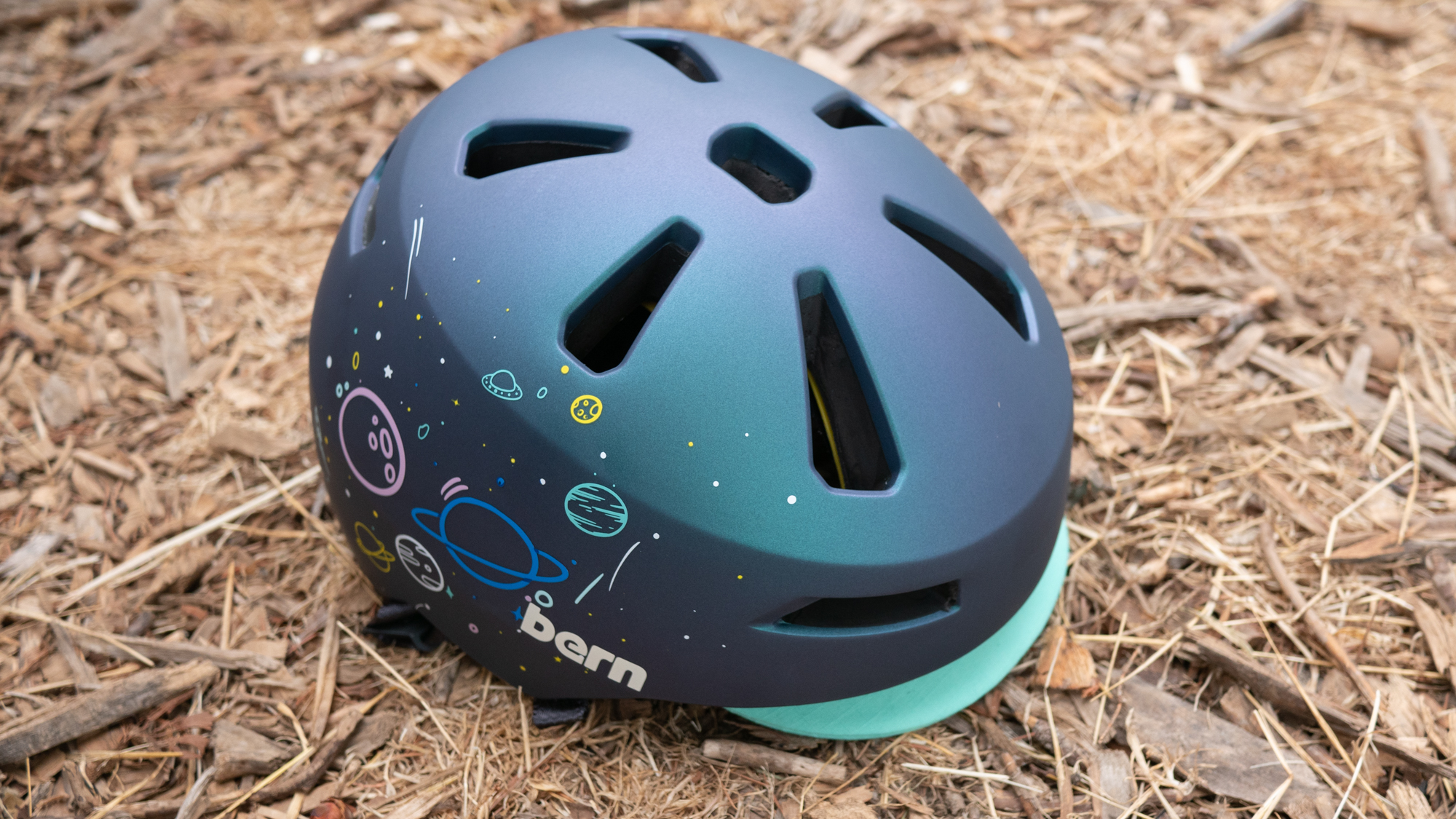
1. Bern Nino 2.0 MIPS
Best overall
Specifications
Sizes: S (52 – 55.5cm / 20.5 – 21.9in), M (55.5 – 59cm / 21.9 – 23.2in)
Ages: 2-5yrs
Colours available : Matte Black, Matte Lime, Matte Grapefruit, Matte Shark Bite, Metallic Space Splat, Matte Fun Fruits, Satin Galaxy Pearl
Visor : Removable soft visor
Rotational Impact Protection : MIPS
Reasons to buy
Cool designs
+No need to adjust the rear cradle
+Winter accessories available
+Light available as an accessory
Buy it if
✅ You want cold protection: Bern sells a liner that keeps little heads warm on cooler rides.
✅ You want to add a rear light: A blinkie is available as an accessory to enhance visibility.
Don’t buy it if
❌ You want easy buckle-up: A magnetic buckle would be a nice add-on making it easier for little hands to use.
❌ You want smaller sizes: There are just two sizes for the Nino, with 52cm the smallest head circumference.
One challenge with skate-style helmets is the weight and lack of ventilation. With the Nino 2.0 Bern has taken a look at exactly those issues. You can still expect the greater coverage of a skate-style helmet but they’ve lightened it and there is more venting than some of the competitors.
Part of that drive for a light and durable helmet is something Bern calls. Zip Mold+ foam technology. The outer layer of the helmet uses a durable PVC that’s tough enough to minimise its weight. Inside of that is a proprietary Zip Mold+ liquid-injected foam that allows the brand to use just enough foam and not more. The effect is a helmet that’s both tough enough for everyday bumps when off the head as well as light enough to remain safe and comfortable on the head.
The feature that really sets the Bern Nino apart though is the accessories available. Specifically, Bern offers a cold weather liner that allows kids to stay warm while riding when it’s chilly. You could use a hat in any helmet but this way the fit isn’t compromised and it’s one less thing to worry about keeping track of. What would be really nice is if Bern also added a magnetic buckle to the mix, as standard buckles can be difficult for kids and require adults to take care not to pinch any skin.
Best Value
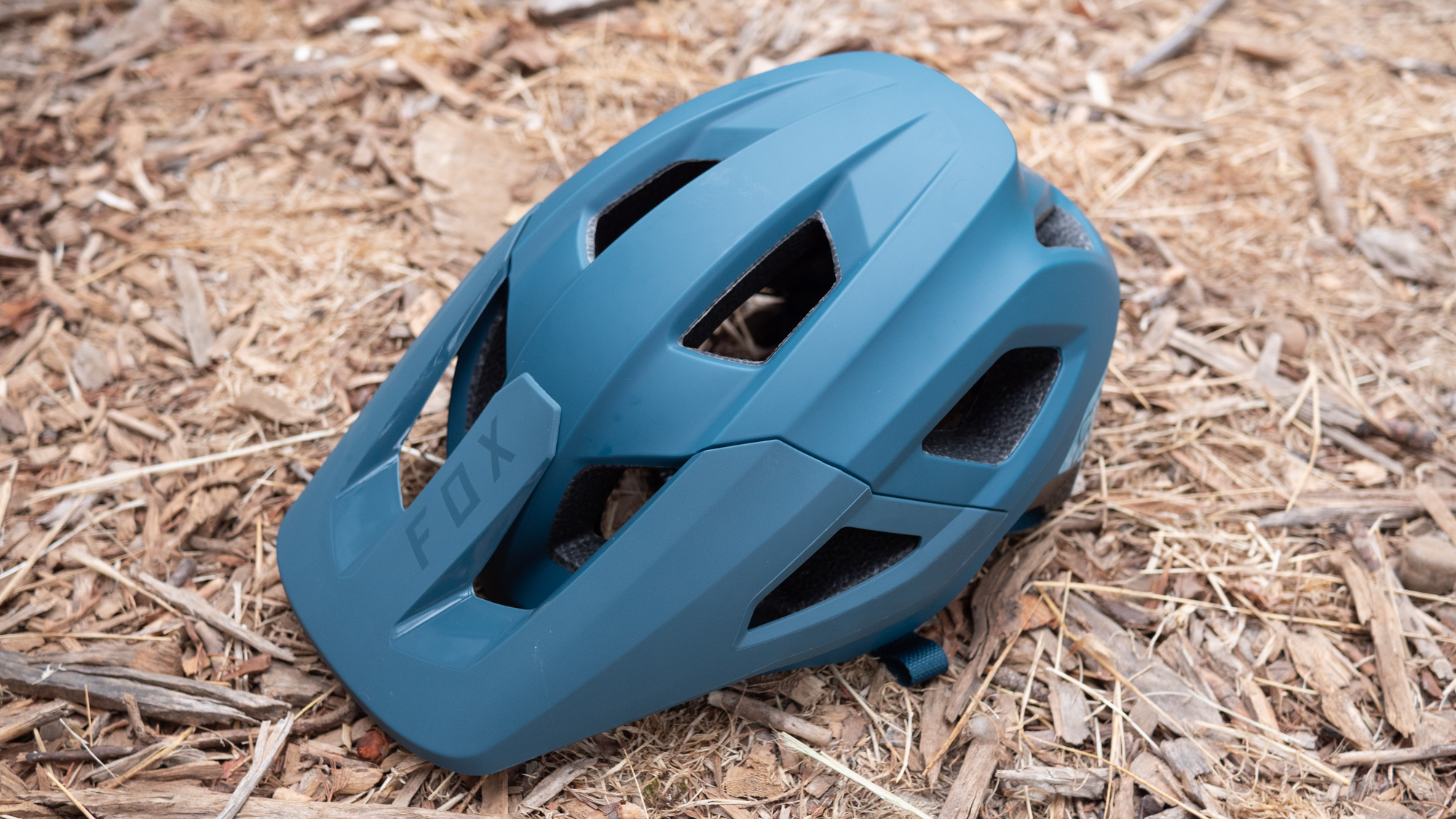
2. Fox Racing Youth Mainframe Helmet
Best Value
Specifications
Sizes available : OS (48–52cm / 18.9–20.5in)
Ages: 6+yrs
Colours available : Slate blue, Flo Red, Tortoise/Bronze, Flo Yellow
Visor : Integrated
Rotational Impact Protection : MIPS
Reasons to buy
Replaceable visor
+Adult style
+Lots of ventilation
+Lightweight
Reasons to avoid
Lacks vertical rear cradle adjustment
–Old style MIPS liner
Buy it if
✅ You want a helmet for junior mountain biking: The Youth Mainframe has classic MTB styling for you shredders.
✅ You want low weight: The helmet is pretty low in weight making it more comfortable to wear.
Don’t buy it if
❌ You want to avoid hair tangles: The older style MIPS liner can trap longer hair.
❌ You need more cradle adjustment: The position of the rear cradle is fixed in a position.
Fox Racing is one of the biggest and best-known brands in mountain biking. The brand offers a wide range of products for mountain biking including helmets. Among those offerings is the Speedframe as a general-purpose mountain bike helmet. To make sure kids are covered with the same great quality, the Fox Racing Youth Mainframe takes the same iconic design of the Speedframe and sizes it down.
Adult or kid, helmets designed for use on a mountain bike have a couple of differences. Like skate-style helmets, they come down a bit farther in the back and on the sides. They also use a much bigger visor to help shield the sun as you sit more upright on a mountain bike. On top of functional reasons, there’s some amount of style involved as well. The Fox Youth Mainframe MIPS brings those advantages to a kid in a helmet that at 337 grams feels quite light and certainly looks the part.
There are some disadvantages carried over from the adult helmet as well. MIPS is a great technology to have on a helmet but MIPS technology has been updated over the years. Both the adult Speedframe and the youth Mainframe still use the older style MIPS though. For many, it won’t matter but it can catch long hair. There’s also no vertical adjustment in the rear cradle limiting overall adjustment.
Although there are some small details that could use massaging, the Fox Racing youth Mainframe does a great job of mimicking an adult mountain bike helmet. It’s light and airy with a quality visor. If your kid is on a mountain bike this is a great option.
Best Style
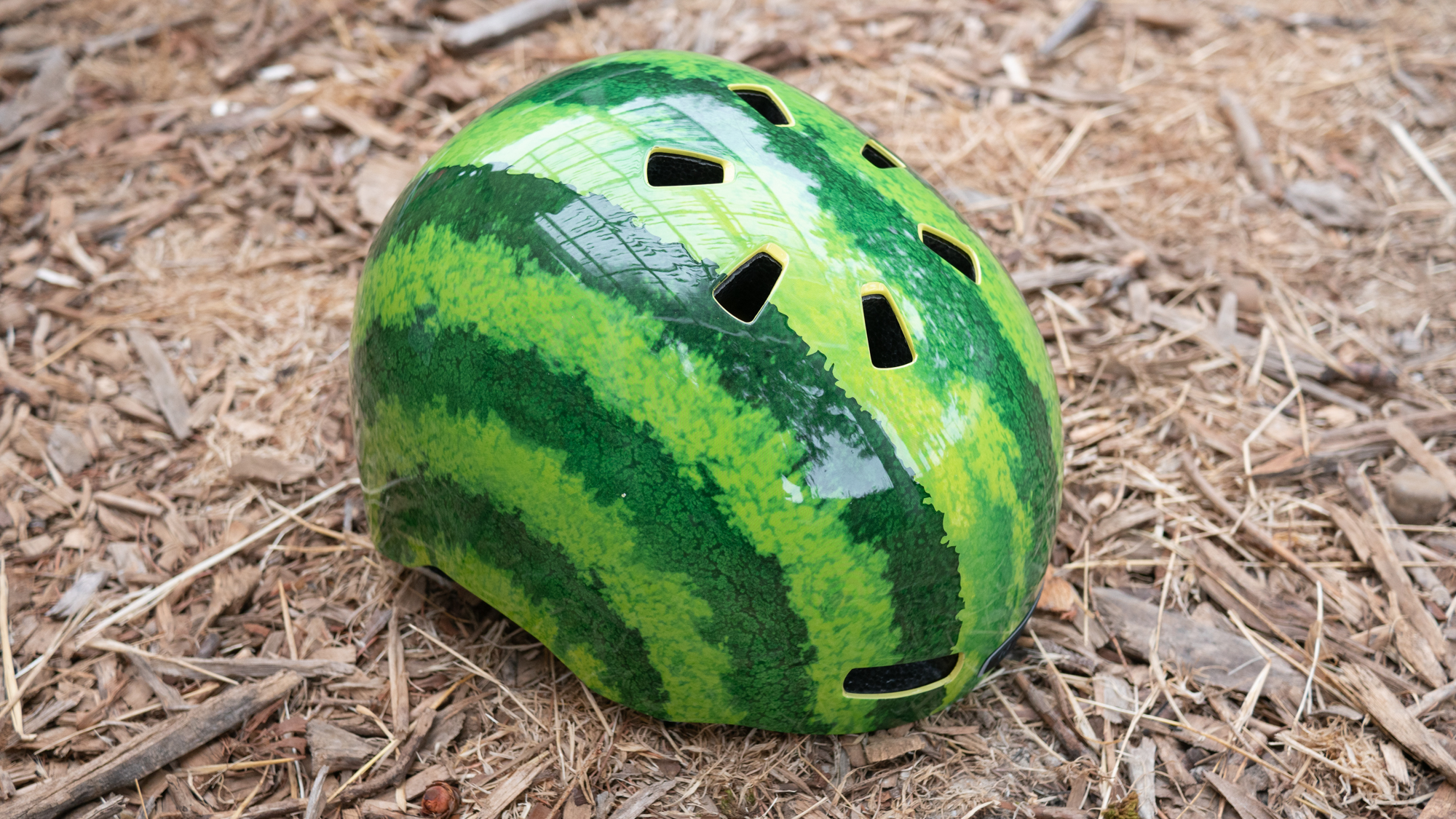
3. Nutcase Helmets Little Nutty
Best kids’ bike helmet if you want lots of creative styles
Specifications
Sizes: Toddler (48–52cm / 18.9–20.5in), Youth (52–56cm / 20.5–22in)
Ages: Toddler: 3-5yrs, Youth: 7yr+
Colours available : Huge range of rotating designs
Visor: Clip-on included
Rotational Impact Protection : MIPS
Reasons to buy
Plastic exterior protects against small drops and bumps
+Amazing designs
+Visor is included and optional
+Magnetic buckle that won’t pinch
Reasons to avoid
A bit heavier than the competition
Buy it if
✅ You want creative designs: There are loads of shell designs to appeal to kids.
✅ You want a magnetic buckle: It makes putting the helmet on and taking it off a lot easier.
Don’t buy it if
❌ You want lower weight: Nutcase’s helmet is heavier than some.
❌ You want more venting: The number and size of vents are fairly modest.
My kiddo has the opportunity to give his opinion on a lot of helmets. His general attitude is resignation and apathy. He checks them out, gives an opinion and moves on. When the Nutcase Little Nutty arrived, it was a totally different experience. He opened up the Watermelon w/MIPS and his eyes lit up. He thought it was hilarious and wanted to go for a ride right away. That helmet is gone now but the brand is constantly rotating in new styles. When it comes to helmets, fashion matters and Nutcase makes great-looking helmets that are fun to wear.
Even with the emphasis on style though, there’s plenty of safety on board. The skateboard style means extra coverage on the sides and back and while many helmets need replacement in the event of a drop Nutcase helmets hold up to kids a bit better. The thick plastic exterior means light bangs and drops don’t turn a nice helmet into trash. There’s also MIPS on board. Unfortunately, all that does add up to a helmet that is on the heavy side.
When it comes to fit, the Little Nutty Youth is on the large size and works for kids who could move into an adult small. The Little Nutty in toddler size will work for smaller kids and for the smallest riders, there’s also the Baby Nutty.
Best Visibility
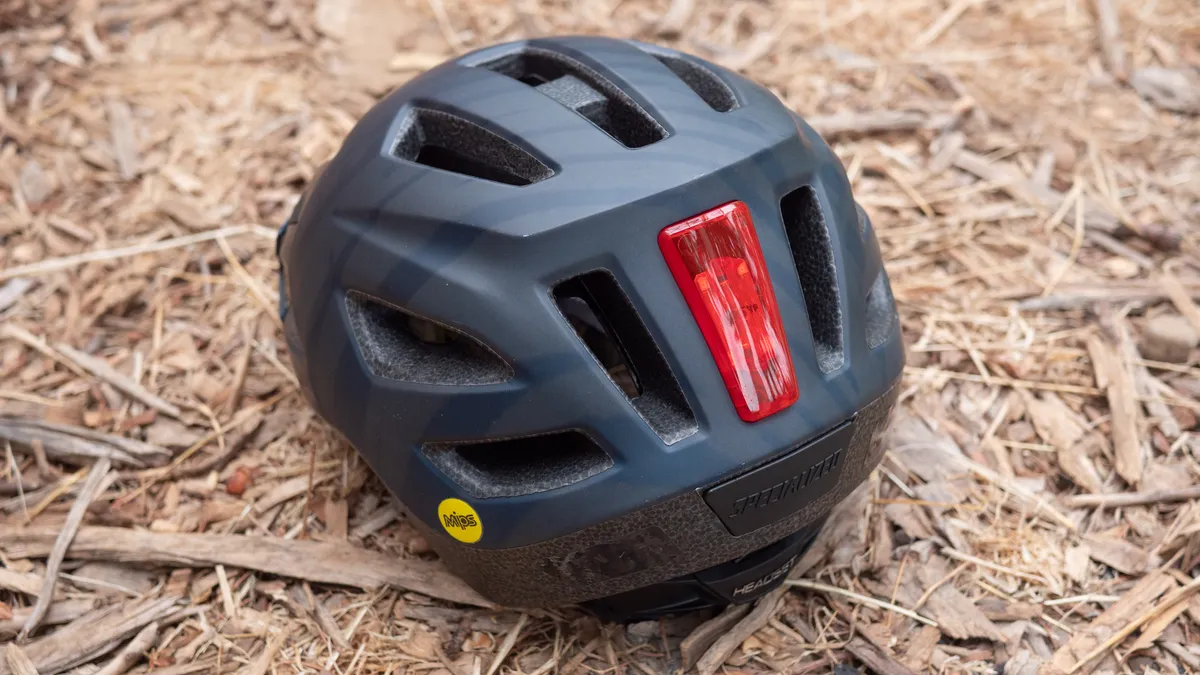
4. Specialized Shuffle Youth LED
Best kids’ bike helmet if you want an integrated light
Specifications
Sizes Available : OS Youth (52–57cm / 20.5–22.4in)
Ages: 7+
Colours Available: Satin Redwood, Satin Smoke, Satin Clay/Cast Umber, Satin Cast Blue Metallic Wild
Visor: Clip on
Rotational Impact Protection : MIPS
Reasons to buy
Integrated LED
+Specialized ANGi crash sensor compatibility
+Side straps don’t require adjustment
Reasons to avoid
Light is difficult to turn on and non-rechargeable
Buy it if
✅ You want added protection features: An integrated light and the option to add an ANGi crash sensor are nice add-ons.
✅ You want an integrated light: The large rear light increases visibility during the day or at night.
Don’t buy it if
❌ You want a rechargeable light: The Shuffle light runs on non-rechargeable batteries.
❌ You want a light that’s easier to turn on: We found pressing the lens required some force.
Day or night, one of the best ways to increase visibility on a bike is with a light. I also handle our guide to the best bike lights and I’m a big proponent of putting tons of lights on everyone’s bikes, especially urban bikes and bikes for kids. My son has pedals with lights and there’s normally a front and rear light on his bike. At the same time, I know all that stuff is kind of a hassle and not everyone is going to use it. Including an integrated light on a helmet makes adding visibility easy.
The Specialized Shuffle Youth LED is a mountain bike-style helmet that addresses the need without costing a fortune. In the rear of the helmet, you will find an integrated light that turns on with only a press of the lens. It is a little tough to actually press so, at least at first, it’s probably a good idea to press it before putting the helmet on a head.
The light isn’t the only feature worth noting either. There’s also extended side and rear coverage as well as a visor. The side straps don’t have an adjustable Y-connector which could limit adjustability but, since Specialized got them in the right spot, also means there’s no need to bother kids while you fix it for them. For older kids, who might be off on their own, the Specialized ANGi Crash Sensor is compatible with this helmet for even greater parental peace of mind.
Just a note about sizing on this one. There is actually more than one size available but the name is different. If you need a smaller size look for the Shuffle Child LED and for the smallest size you can turn to the Mio MIPS although it does lack the integrated light of the larger two.
Best Versatility

5. Bontrager Jet WaveCel
Best versatile skate style kids’ bike helmet
Specifications
Sizes: Kids (48–52cm / 18.9–20.5in)
Ages: 5-8yrs
Colours: White/Azure -Gloss, Black/Volt -Matte, Vis Green/Royal-Gloss, Magenta/UltraViolet -Gloss
Visor: Integrated
Rotational Impact Protection : Wavecel
Reasons to buy
Magnetic buckle
+Wavecel Technology
+Uncomplicated visual design
Buy it if
✅ You want skate style with rotational protection: Cool styling hides Bontrager’s Wavecel technology.
✅ You want a magnetic buckle: The Jet is another helmet with a buckle that makes it easy to put on.
Don’t buy it if
❌ You want lower weight: The skate style is a little heavy.
❌ You want a matt finish: The gloss finish can show scuffs more easily.
Skate-style helmets are both a style choice and a protection choice. On one hand, the thicker outer and extended coverage that a skate-style helmet provides means more coverage and the ability to stand up to everyday abuses that kids put a helmet through. On the other hand, there’s a pure style element that some kids prefer. If both of those are what you are looking for, then the Bontrager Jet WaveCel provides.
The other thing that this Bontrager helmet provides is rotational impact protection, like what MIPS provides, but without the MIPS liner that can snag long hair. In this case, the technology in use is called WaveCel. It’s a material made up of an open cell structure that looks a little like a bunch of straws held next to each other. It replaces EPS foam in the construction and it does double duty as a replacement for a slip plane technology as well.
Bontrager also puts one of my favourite kid-specific technologies into this helmet, the magnetic buckle. You can also find the Fidlock magnetic buckle in some adult helmets but either way, it uses magnets to attach instead of a buckle. That makes it impossible to pinch the skin and very easy for hands with less strength to get open.
The only downside to the Jet helmet is that, as with other skate-style helmets, it’s a bit heavy.
Best for small heads
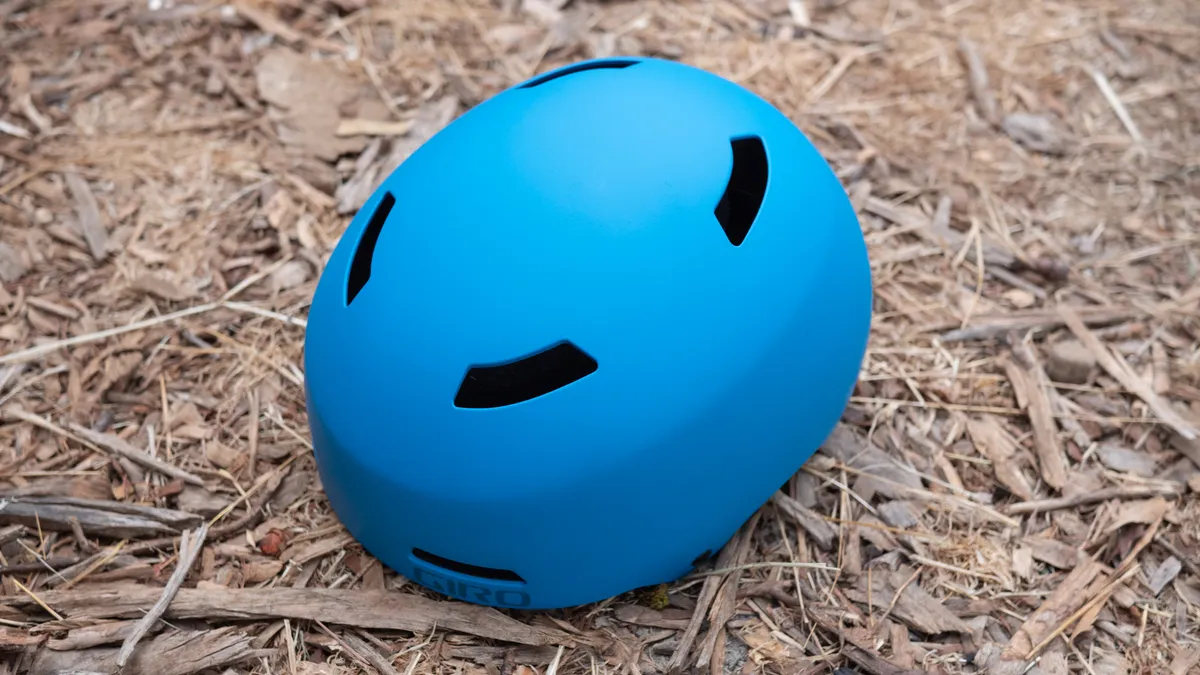
6. Giro Dime MIPS
Best kids’ bike helmet for the smallest kids
Specifications
Sizes : XS (47–51cm / 18.5–20.1in), S (51–55cm / 20.1–21.7in)
Ages: XS: 3-5yr S: 6yr+
Colours available : Matte Black, Matte Blue, Matte Bright Red, Matte Purple, Matte Screaming Teal
Visor: None
Rotational Impact Protection : MIPS
Reasons to buy
Smaller size available
+Amazing designs
+Visor is included and optional
Reasons to avoid
Lacks a magnetic buckle
Buy it if
✅ You want a helmet for a younger child: The Dime is available in XS size.
✅ You want to cover more age ranges: The Dime should fit longer as they get older.
Don’t buy it if
❌ You want a magnetic buckle: The Dime is another helmet with a standard buckle, which can pinch.
❌ You want a helmet for an older kid: With only XS and S sizes available and a 55cm max head size, the Dime may not fit.
Parents know that sizing for kids is overly complicated and confusing. Actually, maybe not all parents know this but I’m sure I’m not alone. There are multiple different size scales and it can be difficult to figure out what scale we are using and when. Plus, especially in bike helmets, there seems to be a rather limited range of time you need specific kids’ sizing. Bottom line, kids need bike helmets from the time they are old enough to go in a trailer all the way up when they move to adult sizing but it’s difficult to find helmets for the littlest kids.
I wanted to make sure to include a quality helmet for the smallest kids using balance bikes or riding with an adult. Predictably though, it’s not a simple thing. The very first helmet you might need is going to be the Giro Scamp MIPS. As the name suggests there is MIPS but there’s also a pinch guard buckle and perhaps useful, there’s an integrated visor. Given that the visor is structural, it’s enough to protect the upper forehead even when they trip. There’s also a bunch of fun colour options.
Now while the Giro Scamp MIPS starts at a 45cm head size, the Giro Dime MIPS is only a little bigger at 47cm for the XS. Both are great helmets, but the skate-style Giro Dime MIPS is likely a more usable range for most kids, plus the skate-style design should hold up better given the heavy plastic outer. You’ll have to do some measuring but for my child, the time he was actually on a bike aligned better with the slightly bigger Dime. Just be prepared to get down low and make sure you aren’t pinching your kid’s neck because there’s no magnetic buckle in this helmet.
Best for long hair

7. Lazer Nutz Kineticore
Best kids helmet for long hair
Specifications
Sizes: OS (50–56cm / 19.7–22.0in)
Ages: 5-8yrs
Colours Available: Space, Black, Black Flash Yellow, Dragons, Butterfly, Unicorns
Visor: None
Rotational Impact protection: Kineticore
Reasons to buy
Great design options
+Rotational Impact protection without a MIPS liner
+Extended rear and side protection
+Cheek buckle
Buy it if
✅ You want a helmet for long hair: Lazer KinetiCore won’t catch on hair, which MIPS can do.
✅ You want good rear and side protection: The Nutz helmet sits a little lower than some other helmets.
Don’t buy it if
❌ You want a visor: There’s no option to fit one to the Nutz.
❌ You want a magnetic buckle: Although positioned at the side of the helmet, Lazer’s clip-in buckle is still tricky to use.
Most of the helmets on this list use MIPS. MIPS stands for Multi-directional Impact Protection System and is a technology that allows for rotation of a helmet, around the skull, in a crash. Part of the early generation of MIPS technology is a liner and not everyone loves the feel of that liner and long hair can catch in it. At the same time, MIPS is also a specific brand and there are other options.
One of the options is what Lazer uses and it’s called Kineticore. Kineticore doesn’t use a liner but instead builds what are essentially crumple zones right into the foam of the helmet. You can’t feel them but you still get the benefit of rotational impact protection without any chance of long hair catching.
The Lazer Nutz Kineticore and Lazer Pnut Kineticore are the Kineticore options that Lazer makes available for younger riders. Along with Kineticore the Lazer Nutz also increases rear and side coverage as well as offering eight different designs. For the adults who have to buckle helmets, Lazer has moved the placement of the buckle to the cheek to minimise pinching issues. Unfortunately, the buckle used is still a standard, non-magnetic, design.
If your kid has long hair the Lazer Kineticore helmets are an excellent option.
How to choose
Does it fit comfortably?
Is the sizing right for your kid’s head and is the shape of the helmet a match for their head shape, so that it doesn’t move around? Is there room and adjustment to fit as they grow? Can you fit a cap underneath if it’s cold?
Are the straps comfortable?
Kids may not like the straps, but they need to be adjustable to fit well. A magnetic buckle can help when putting the helmet on and removing it.
Do they like the design/colour?
Kids are more likely to be happy to wear their helmets if they like the look. They probably want a helmet to match their riding too, whether that’s a skate park, mountain biking or general road and off-road play.
Is there the right level of venting?
A helmet without enough vents can get uncomfortably hot in hot weather. On the other hand, one with too much airflow can feel too cold in winter weather.
Is there additional rotational impact protection?
A system such as MIPS or KinetiCore can add extra protection in a crash by reducing rotational forces. While kids may not be crashing at high speeds, more protection is always better. If you don’t know what MIPS is, check out our in-depth MIPS guide.
Does it feel too heavy?
Whether you’re an adult or a child, a lighter helmet is going to be more pleasant to wear when riding. Kids will probably complain if they think a helmet is too weighty and discourage them from wearing it.
Does it feel too heavy?
Whether you’re an adult or a child, a lighter helmet is going to be more pleasant to wear when riding. Kids will probably complain if they think a helmet is too weighty and discourage them from wearing it.
Everything you need to know
How do I measure my kid’s head size?
Helmet sizes are usually measured in centimetres around the circumference of their heads. That’s true for adult helmets as well as kids’ bike helmets.
The best way to measure your child’s head size is to use either a cloth tape or a piece of string. If you use the string method, just use a ruler to measure the string’s length. Measure around the largest section of their head, horizontally just above the ears, making sure that you take in the brow and the occipital lobe, the bump on the rear of the skull.
How do I make sure the fit is right?
Everybody buys clothes big and lets their kids grow into them. When I sat down and chatted with Isla Rowntree, founder of Islabikes, she relayed that bikes for children typically last three years but are only optimally sized for one. The first year they are too small for the bike and the last year the bike is too small for them. Only during the middle year does the bike fit a child perfectly. All that is to say everything your kid owns only fits for a short time but a helmet has to be right all the time. Don’t buy a helmet too big and let them grow into it. Also, don’t let it stick around too long when it’s small.
The helmet should sit low on a child’s head in the front and should be stable once properly adjusted. If it sits too far back or flops around, it’s not the right size. It should also be comfortable and if it’s too tight it’s not the right helmet. There’s a good amount of adjustability in a helmet so you should be able to find one that will last for a while. But never buy one that doesn’t fit. A helmet that doesn’t fit isn’t safe.
Some helmets come with multiple pad sets with different thicknesses, so you can alter the fit as your child’s head grows. All will have a rear cradle with a dial adjuster or slider that lets you adjust the fit for the circumference and depth of their head.
When else should I replace my child’s helmet?
Besides replacing a helmet that they’ve grown out of, you should always replace a helmet that’s been in a crash which involves a head impact. The EPS foam and the shell may have been damaged so they’ll be less protective in a subsequent crash and this is not always visible.
The same is true of a helmet that has been dropped. Although kids’ helmets are usually designed with an extra level of abuse resistance over lightweight adult helmets, if it’s fallen down the stairs, for example, a helmet may become damaged. A helmet should also be stored out of direct sunlight and shouldn’t be left in a car on a hot day.
Most helmet makers say you should replace a helmet after a period of use, often five years, as the EPS foam will degrade over time. Your kid will almost certainly have grown out of their helmet by then, but it’s worth keeping in mind for hand-me-downs.
What is MIPS?
Helmets are really good at keeping you from a head injury in the event of a crash. At one point in time, saying that would have been a big deal, but at this point, it’s kind of the baseline requirement. Any helmet on the market will meet a variety of minimum requirements in order to be sold in a particular country. But it turns out there’s a lot more to keep you safe than that baseline.
When an impact occurs at an angle, which it almost always does, if your head stops moving very abruptly it can cause your brain to move or stretch within your skull. Your child can experience a traumatic brain injury, more often referred to as a concussion, from the brain moving inside the skull. The current thinking is that the best way to solve this is to allow for some movement between the helmet and the skull.
MIPS is a brand name that stands for Multi-directional Impact Protection System. It is one brand’s solution to the problem and the technology is licensed by various helmet brands, but there are other solutions to the same problem with other brand names applied. On our list of the best kids’ cycling helmets, there is MIPS, Lazer’s Kineticore, and Bontrager’s Wavecel technology represented but there are others as well.
Does your child’s helmet need MIPS?
If you are purchasing a helmet for your child, or for you, it’s a good idea to have some form of technology designed to allow for angular rotation. It is not a guarantee that the wearer has complete protection against concussion, but right now, the general consensus of research suggests that this type of technology is helpful. That’s not to say that a helmet without rotational impact protection technology is unsafe. All helmets have to meet required safety standards before being sold. Even if a helmet doesn’t have rotational impact protection it’s safe.
Instead of considering the choice binary, I prefer to look at it as a consideration. There is a helmet for every size kid that includes some type of rotational impact protection. There’s no drawback so it makes sense to include it in the helmet you buy.
Does your kid’s helmet need a visor?
A visor on a helmet is both a fashion choice and a functional choice. If your child has a very upright bike, a visor makes sense to help keep the sun out of their eyes. Bikes that keep the head lower mean that a visor will get in the way of visibility. A visor may also help stop branches and other obstacles hitting them in the face.
In practical terms that means road bike helmets don’t have visors and mountain bike helmets often do. If the bike your child has, as well as the style you and your child are going for, match up with a visor then they are helpful depending on the design. Many kids think the visor looks cool and it’s often removable too.
Does the buckle style matter?
The short of it is that a good buckle is worth shopping for. No parent wants to hurt their kid and it’s easy to hurt them with the wrong buckle. When you help a child buckle their helmet you are often above them, making the area under their chin difficult to see. Even if you get down on a knee it can be hard to judge where the buckle is in comparison to the skin. Not only that but it’s a sensitive area and skin pinched in the buckle will hurt!
As a parent, you’ll go through a lot to make sure you don’t catch your kiddo’s skin in the buckle. That might mean lots of extra time being careful but it can also mean making the strap looser so it’s less of an issue. A strap that’s too loose means the helmet is less effective and all the extra time isn’t fun for anyone. Instead, look for a buckle that makes life easier with some kind of no-catch system. Magnetic buckles are easy to use.
Does my child need to wear a helmet when cycling?
In much of the world, there’s no legal requirement to wear a helmet for cycling. Most adults do wear one nowadays though and it’s sensible to provide the extra protection that a helmet provides to your offspring when they are cycling.
Kids don’t always judge the risk involved in a manoeuvre as well as an adult, so they’re more likely to take a tumble. It’s then that a helmet adds extra safety, even if their riding speed is likely to be lower than yours. Choose a cool helmet and they’re less likely to make a fuss about wearing it.
How we test?
We take testing seriously at Cyclingnews—especially when it comes to critical safety equipment such as kids’ bike helmets. For this guide, we tested eight helmets across multiple months and riding conditions, including pavement, gravel, school runs, and family trail rides. Given how crowded the category is, we focused on several key criteria to carefully shortlist the best kids’ bike helmets available today.
Of course, safety standards were an absolute imperative. We started by shortlisting helmets that met key safety standards such as CPSC (US) and EN 1078 (EU). While we can’t crash-test the helmets ourselves, we can simulate wear and tear and durability by dropping them, storing them in bags, and exposing them to sun and rain.
We also prioritised helmets from trusted brands with a history of quality and made sure to include a mix of budget, mid-range and premium options—some with MIPS, others without—to suit a range of needs and price points.
Each helmet was assessed for true-to-size fit, how well it stayed in place during riding, comfort over longer rides, how easily a child could put it on or adjust it themselves, and general durability. We paid special attention to strap adjustment systems and dial retention mechanisms since proper fit is vital to safety.
Testing is the backbone of our tech department, and we always aim to provide reliable, unbiased advice. Check out our how we test page if you’d like further information.







